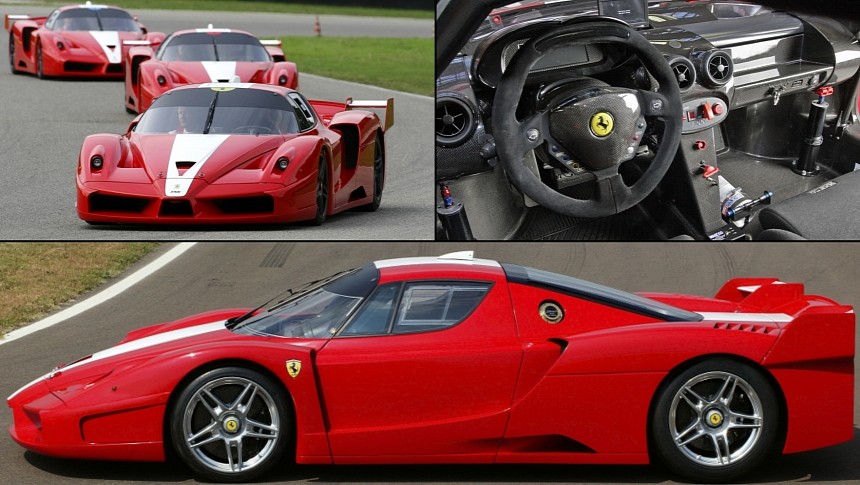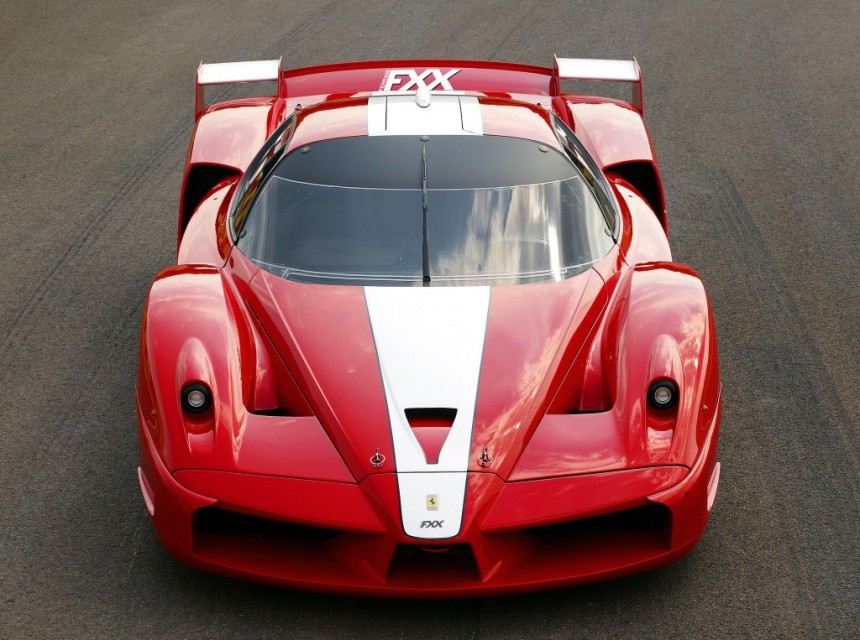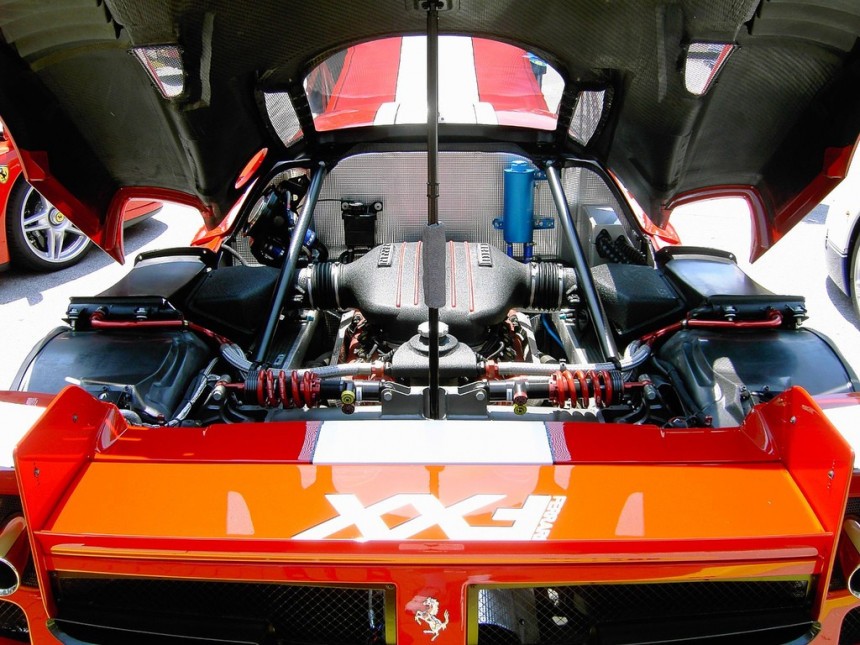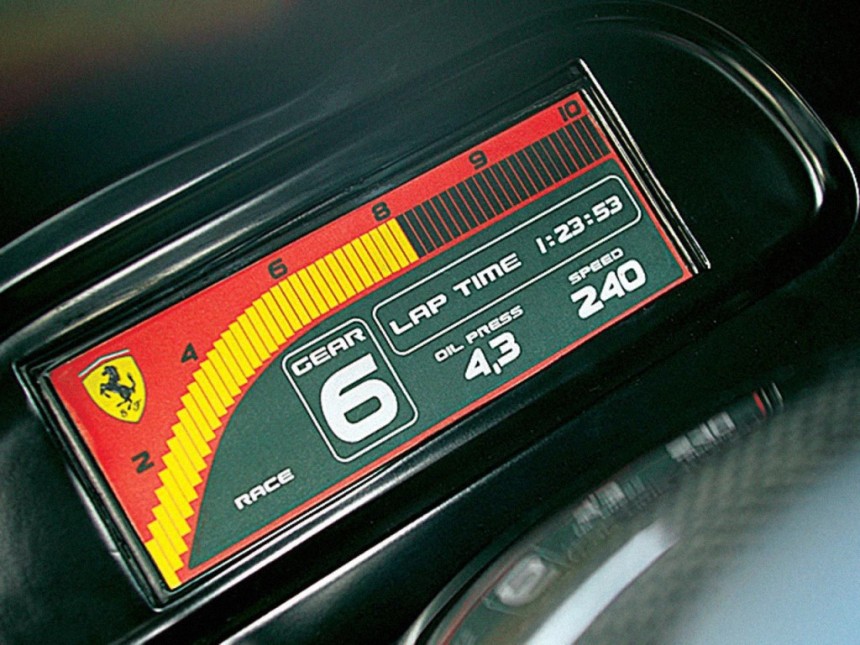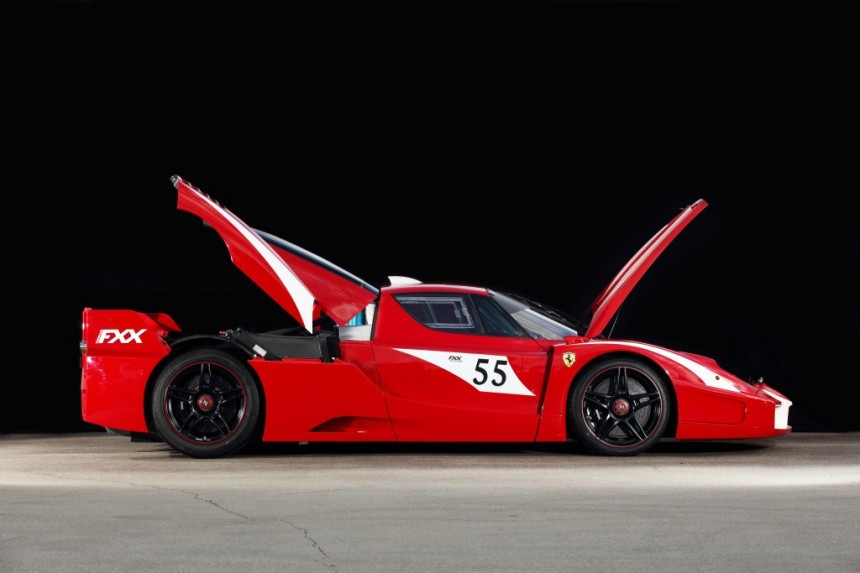Ferrari has a long history of road-legal cars adapted for track-only action. Those developed under the XX Program stand out for a number of reasons, chief among which is that clients of the XX Program don't actually own the vehicles in question.
As opposed to the road-going equivalent, said track cars feature next-gen technologies and motorsport know-how that Ferrari doesn't want to be copied by competing automakers and racing teams. There is another side to this apparently unconventional arrangement, that side being logistics and maintenance. Why not let a crack team of specialists do it on your behalf? All you have to do is enjoy the car on the track.
Any car out there can be tracked, but there's nothing quite like the cars that Ferrari offered – and continues to offer – under the XX Program. The progenitor comes in the guise of the FXX, an Enzo-based marvel of engineering that is much rarer than its road-legal sibling. Maserati developed a similar vehicle in the form of the MC12 Versione Corsa, although the sole difference between it and the FXX is that clients actually owned those race-prepped machines. The Aventador-based Essenza SCV12 from Lamborghini follows the same recipe.
The XX Program wouldn't have been possible without Ferrari's keen business sense. The Prancing Horse of Maranello was – and is – aware that the insanely rich like toys, and the ultimate toy for a car enthusiast is driving the next best thing to an actual racing car from the best company in the business. XX Program clients also serve as test drivers in all but name, because all the driving data is monitored and interpreted by Ferrari to further the Italian brand's road-going cars and racecars. Charging test drivers rather than paying them for their services? Sounds crazy, but it actually works.
Part of the reason why the XX Program was a commercial success from the outset was Michael Schumacher, the seven-time world champ that made Ferrari a household name with Formula 1 enthusiasts from multiple generations. The FXX became official in June 2005 via an online announcement, then Ferrari unveiled the real thing at the Pebble Beach Concours d’Elegance in August 2005.
The on-track debut followed suit in October 2005 at the Finali Mondiali Ferrari at Mugello. Before going any further with our story on the fabulous FXX, care to guess how much the Cavallino Rampante wanted for the opportunity of driving one?
The pre-tax price of the standard package was 1.5 million euros in 2005, which – accounting for inflation – means 2,122,325 today. Converted to USD, that would be 2,276,090 at current exchange rates. Those numbers wouldn't mean anything without additional context. More specifically, the Enzo had a starting price of $659,330 in the US market when it was launched in 2002. The Bugatti Veyron, by comparison, was €1,225,000 in 2005.
In retrospect, we can agree that Ferrari asked crazy monies for the FXX. On the other hand, XX Program clients received the four-wheeled experience of their lives for said monies. All cars were stored by Ferrari in Maranello, and for a few dollars more, clients could transport their cars to wherever they liked for private sessions on the racetrack. Oh, and by the way, the €1.5 million sticker price of the standard package also included a driving course around the Fiorano test circuit.
From a technical perspective, the beating heart of the FXX is different from the naturally-aspirated V12 of the Enzo. Codenamed F140 DA versus F140 B, this lump displaces 6,262 cubic centimeters (rounded off to 6.3 liters) as opposed to 5,998 cubic centimeters (6.0 liters) for the Enzo. As expected, Ferrari enlarged the F140 engine by increasing the bore from the standard 92 millimeters or 94 millimeters. Also worthy of note, evolutions of the F140 are still used today in the likes of the 812 series, Daytona SP3, and Purosangue.
Another huge difference is the increased compression ratio (13.4:1 compared to 11.2:1), as well as the unrestricted exhaust system. Engine management software is also specific to the FXX, which is fed by port fuel injectors. Gifted with crescent-shaped combustion chambers, continuously variable timing for the intake and exhaust cams, dry-sump lubrication, lightweight alloy heads, a variable length induction system with hydraulic actuators, and titanium connecting rods, the FXX puts its stallions down to the track surface by means of an automated manual transmission supplied by Graziano.
The six-speed gearbox uses a twin-plate clutch of the electro-hydraulic variety. The rear end is also kept in check by a limited-slip differential with a self-locking mechanism. Regarding the next-gen technologies and motorsport know-how mentioned a few paragraphs earlier, the tranny is capable of shifting into the next gear in 80 milliseconds, which is nearly half as quick as the 150 milliseconds of the Enzo.
Equipped with Bridgestone racing slicks mounted on center-lock wheels, the FXX rocks two fuel cells with an overall capacity of 112 liters (29.6 gallons in the US of A or 24.6 gallons in the UK). Only available in left-hand drive, the FXX is bodied in carbon fiber. The chassis is carbon fiber as well, with the roof of the vehicle bonded to said carbon-fiber tub. The V12 powerplant is mounted on a cast-alloy subframe.
Also equipped with air jacks and conventional dampers instead of the Enzo's continuously adaptive dampers, the FXX is both longer and wider than the Enzo. It also sweetens the deal with 40 percent more downforce, and it weighs 100 kilograms (220 pounds) less to boot. It's not quite as fast in a straight line, though, with Ferrari quoting 214 miles per hour or 345 kilometers per hour compared to 218 mph/350 kph.
Unashamedly spartan inside, the FXX belts out 789 horsepower (800 ps) at 8,500 revolutions per minute and 506 pound-feet (686 Nm) of torque at 5,750 revolutions per minute. By comparison, the Enzo "makes do" with 650 horsepower (650 ps) at 7,800 revolutions per minute and 485 pound-feet (657 Nm) at 5,500 revolutions per minute. 30 customer vehicles were produced, with the final example presented to the one and only Michael Schumacher in September 2006 at the Nurburgring XX as a retirement gift.
The FXX story doesn't end here, though. Fast forward to July 2007 at the Suzuka XX, and Ferrari announced the Evoluzione. Existing clients could upgrade their FXXs to Evoluzione spec for yet another 1.5 million euros. More power, more torque, quicker shifts, and 1,000 additional revolutions per minute are the main upgrades, along with next-gen traction control, telemetry, and aerodynamic trickery.
Two seconds a lap quicker around the Fiorano test circuit, the Evoluzione paved the way for the front-engined 599XX. Only three Evoluziones were produced from scratch, the others being converted from the XX Program's first Prancing Horse.
Any car out there can be tracked, but there's nothing quite like the cars that Ferrari offered – and continues to offer – under the XX Program. The progenitor comes in the guise of the FXX, an Enzo-based marvel of engineering that is much rarer than its road-legal sibling. Maserati developed a similar vehicle in the form of the MC12 Versione Corsa, although the sole difference between it and the FXX is that clients actually owned those race-prepped machines. The Aventador-based Essenza SCV12 from Lamborghini follows the same recipe.
The XX Program wouldn't have been possible without Ferrari's keen business sense. The Prancing Horse of Maranello was – and is – aware that the insanely rich like toys, and the ultimate toy for a car enthusiast is driving the next best thing to an actual racing car from the best company in the business. XX Program clients also serve as test drivers in all but name, because all the driving data is monitored and interpreted by Ferrari to further the Italian brand's road-going cars and racecars. Charging test drivers rather than paying them for their services? Sounds crazy, but it actually works.
Part of the reason why the XX Program was a commercial success from the outset was Michael Schumacher, the seven-time world champ that made Ferrari a household name with Formula 1 enthusiasts from multiple generations. The FXX became official in June 2005 via an online announcement, then Ferrari unveiled the real thing at the Pebble Beach Concours d’Elegance in August 2005.
The on-track debut followed suit in October 2005 at the Finali Mondiali Ferrari at Mugello. Before going any further with our story on the fabulous FXX, care to guess how much the Cavallino Rampante wanted for the opportunity of driving one?
The pre-tax price of the standard package was 1.5 million euros in 2005, which – accounting for inflation – means 2,122,325 today. Converted to USD, that would be 2,276,090 at current exchange rates. Those numbers wouldn't mean anything without additional context. More specifically, the Enzo had a starting price of $659,330 in the US market when it was launched in 2002. The Bugatti Veyron, by comparison, was €1,225,000 in 2005.
In retrospect, we can agree that Ferrari asked crazy monies for the FXX. On the other hand, XX Program clients received the four-wheeled experience of their lives for said monies. All cars were stored by Ferrari in Maranello, and for a few dollars more, clients could transport their cars to wherever they liked for private sessions on the racetrack. Oh, and by the way, the €1.5 million sticker price of the standard package also included a driving course around the Fiorano test circuit.
From a technical perspective, the beating heart of the FXX is different from the naturally-aspirated V12 of the Enzo. Codenamed F140 DA versus F140 B, this lump displaces 6,262 cubic centimeters (rounded off to 6.3 liters) as opposed to 5,998 cubic centimeters (6.0 liters) for the Enzo. As expected, Ferrari enlarged the F140 engine by increasing the bore from the standard 92 millimeters or 94 millimeters. Also worthy of note, evolutions of the F140 are still used today in the likes of the 812 series, Daytona SP3, and Purosangue.
Another huge difference is the increased compression ratio (13.4:1 compared to 11.2:1), as well as the unrestricted exhaust system. Engine management software is also specific to the FXX, which is fed by port fuel injectors. Gifted with crescent-shaped combustion chambers, continuously variable timing for the intake and exhaust cams, dry-sump lubrication, lightweight alloy heads, a variable length induction system with hydraulic actuators, and titanium connecting rods, the FXX puts its stallions down to the track surface by means of an automated manual transmission supplied by Graziano.
The six-speed gearbox uses a twin-plate clutch of the electro-hydraulic variety. The rear end is also kept in check by a limited-slip differential with a self-locking mechanism. Regarding the next-gen technologies and motorsport know-how mentioned a few paragraphs earlier, the tranny is capable of shifting into the next gear in 80 milliseconds, which is nearly half as quick as the 150 milliseconds of the Enzo.
Equipped with Bridgestone racing slicks mounted on center-lock wheels, the FXX rocks two fuel cells with an overall capacity of 112 liters (29.6 gallons in the US of A or 24.6 gallons in the UK). Only available in left-hand drive, the FXX is bodied in carbon fiber. The chassis is carbon fiber as well, with the roof of the vehicle bonded to said carbon-fiber tub. The V12 powerplant is mounted on a cast-alloy subframe.
Also equipped with air jacks and conventional dampers instead of the Enzo's continuously adaptive dampers, the FXX is both longer and wider than the Enzo. It also sweetens the deal with 40 percent more downforce, and it weighs 100 kilograms (220 pounds) less to boot. It's not quite as fast in a straight line, though, with Ferrari quoting 214 miles per hour or 345 kilometers per hour compared to 218 mph/350 kph.
Unashamedly spartan inside, the FXX belts out 789 horsepower (800 ps) at 8,500 revolutions per minute and 506 pound-feet (686 Nm) of torque at 5,750 revolutions per minute. By comparison, the Enzo "makes do" with 650 horsepower (650 ps) at 7,800 revolutions per minute and 485 pound-feet (657 Nm) at 5,500 revolutions per minute. 30 customer vehicles were produced, with the final example presented to the one and only Michael Schumacher in September 2006 at the Nurburgring XX as a retirement gift.
The FXX story doesn't end here, though. Fast forward to July 2007 at the Suzuka XX, and Ferrari announced the Evoluzione. Existing clients could upgrade their FXXs to Evoluzione spec for yet another 1.5 million euros. More power, more torque, quicker shifts, and 1,000 additional revolutions per minute are the main upgrades, along with next-gen traction control, telemetry, and aerodynamic trickery.
Two seconds a lap quicker around the Fiorano test circuit, the Evoluzione paved the way for the front-engined 599XX. Only three Evoluziones were produced from scratch, the others being converted from the XX Program's first Prancing Horse.
